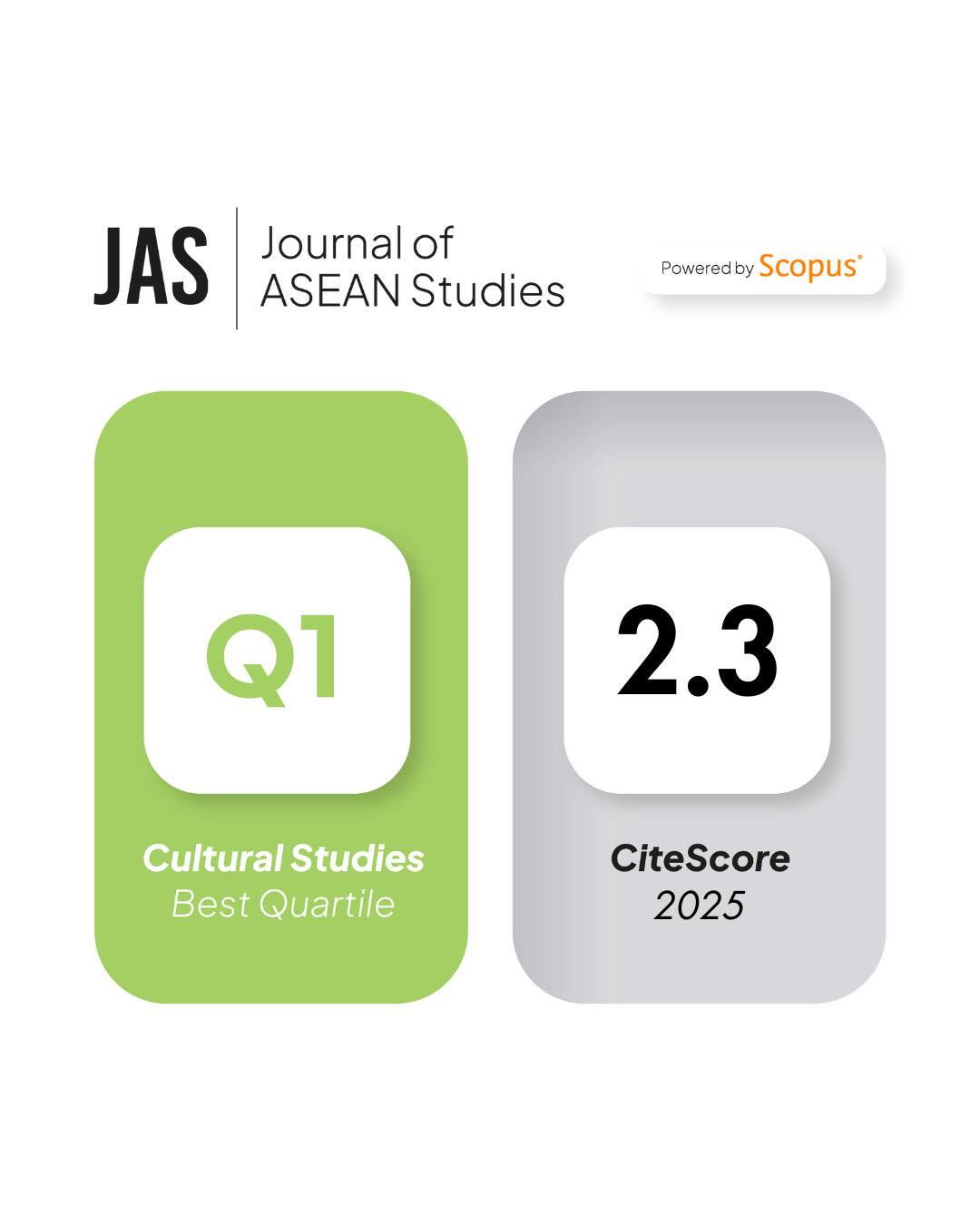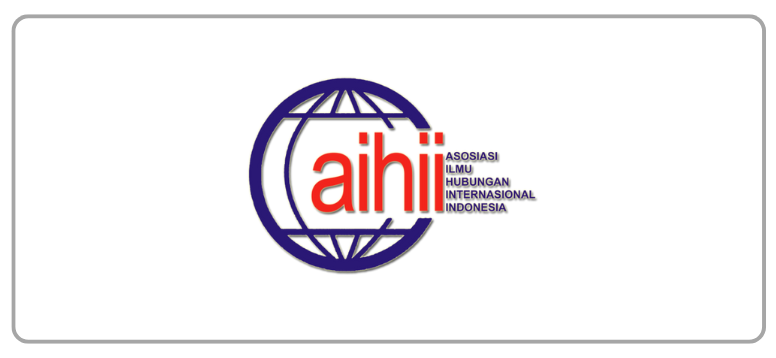A Focal Point of Coordination: A Case Study of the ASEAN-Indonesia National Secretariat’s Coordination Efforts
DOI:
https://doi.org/10.21512/jas.v13i1.12398Keywords:
ASEAN-Indonesia National Secretariat, ASEAN Charter, Indonesian government, policy transfer, democratic foreign policy makingAbstract
The research assessed the internalization of the 2007 Charter of the Association of Southeast Asian Nations or the ASEAN Charter into national legislation, particularly on the mandate stipulated in Article 13, to establish an ASEAN National Secretariat for each ASEAN member state. The case study provided an overview of the ASEAN-Indonesia National Secretariat, to examine the regional-level to national-level policy transfer of ASEAN cooperation adopted by the Indonesian government and demonstrates the democratic foreign policy-making process in Indonesia. A qualitative content analysis was applied to assess the official and legal documents regarding the ASEAN-Indonesia National Secretariat. The research finds that the Indonesian statutory provisions stipulate that the ASEAN-Indonesia National Secretariat is a focal point of coordination for ASEAN cooperation in Indonesia, where the Indonesian Ministry of Foreign Affairs is the main supporting unit and functions as a public relation for advocating ASEAN awareness of the Indonesian people. The study is expected to contribute to the literature on international relations and public administration, where Indonesia’s experience in constructing a coordinated policy network among governmental institutions for the implementation of ASEAN regional commitments in domestic settings could be a model for other ASEAN member states or other regional framework.
References
Acharya, A. (2004). How ideas spread: Whose norms matter? Norm localization and institutional change in Asian regionalism. International Organization, 58(2), 239–275. https://doi.org/10.1017/S0020818304582024
Acharya, A. (2014). Constructing a security community in Southeast Asia: ASEAN and the problem of regional order (3rd ed.). Routledge. https://doi.org/10.4324/9781315796673
Acharya, A. (2021). ASEAN and regional order: Revisiting security community in Southeast Asia (1st ed.). Routledge. https://doi.org/10.4324/9781003122333
Aggarwal, V. K., & Chow, J. T. (2010). The perils of consensus: How ASEAN’s meta-regime undermines economic and environmental cooperation. Review of International Political Economy, 17(2), 262–290. https://doi.org/10.1080/09692290903192962
ASEAN. (n.d.-a). ASEAN Chairmanship. https://asean.org/category/chairmanship/
ASEAN. (n.d.-b). External Relations – Overview. https://asean.org/our-communities/asean-political-security-community/outward-looking-community/external-relations/
ASEAN. (n.d.-c). National focal point. https://asean.org/national-focal-point/
ASEAN. (n.d.-d). ASEAN sectoral ministerial bodies. https://asean.org/who-we-work-with/asean-sectoral-ministerial-bodies/
ASEAN. (2008). The ASEAN Charter. https://asean.org/wp-content/uploads/images/archive/publications/ASEAN-Charter.pdf
ASEAN. (2015). ASEAN 2025: Melangkah maju bersama (Kementerian Luar Negeri Republik Indonesia, Trans). Sekretariat Nasional ASEAN-Indonesia. https://setnasasean.kemlu.go.id/site/uploads/document/book/599e3d513d507-asean-2025-melangkah-maju-bersama.pdf
ASEAN. (2022, November 10). ASEAN Leaders’ Statement on the Application of Timor-Leste for ASEAN Membership. https://asean.org/asean-leaders-statement-on-the-application-of-timor-leste-for-asean-membership/
ASEAN. (2023). List of ASEAN Directors-General (as of January 2023). https://asean.org/wp-content/uploads/2023/01/Distribution-List-ASEAN-DGs-as-of-Jan-2023.pdf
ASEAN-Indonesia National Secretariat. (n.d.). Tentang Setnas – Indonesia. Retrieved April 18, 2025, from https://setnasasean.kemlu.go.id/tentang-setnas
BBPMP Jawa Timur. (2023, January 8). Buku bahan pengajaran ASEAN bagi pendidikan dasar. https://bbpmpjatim.kemdikbud.go.id/jelita/buku-bahan-pengajaran-asean-bagi-pendidikan-dasar
Bulmer, S., & Padgett, S. (2005). Policy transfer in the European Union: An institutionalist perspective. British Journal of Political Science, 35(1), 103–126. https://doi.org/10.1017/S0007123405000050
Caballero-Anthony, M. (2022). The ASEAN way and the changing security environment: navigating challenges to informality and centrality. International Politics, 1–21. https://doi.org/10.1057/s41311-022-00400-0
Dolowitz, D., & Marsh, D. (1996). Who learns what from whom: A review of the policy transfer literature. Political Studies, 44(2), 343–357. https://doi.org/10.1111/j.1467-9248.1996.tb00334.x
Government of Timor-Leste. (2016, March 21). Timor-Leste making all necessary preparations for ASEAN membership. Government of Timor-Leste. http://timor-leste.gov.tl/?p=14835&lang=en
Hammond, T. H., & Prins, B. C. (2006). Domestic veto institutions, divided government, and the status quo: A spatial model of two-level games with complete information. In R. Pahre (Ed.), Democratic foreign policy making: Problems of divided government and international cooperation (pp. 21–82). Palgrave Macmillan US. https://doi.org/10.1057/9780230601444_2
Indorf, H. H. (1975). ASEAN: Problems and prospects. Institute of Southeast Asian Studies
Jetschke, A. (2017). What drives institutional reforms in regional organisations? Diffusion, contextual conditions, and the modular design of ASEAN. TRaNS: Trans -Regional and -National Studies of Southeast Asia, 5(1), 173–196. https://doi.org/10.1017/trn.2016.30
Kementrian Luar Negeri Indonesia. (n.d.). Struktur organisasi. https://kemlu.go.id/tentang-kami/struktur-organisasi
Kementerian Sekretariat Negara Republik Indonesia. (2023, February 21). Jalin kolaborasi, Kemensetneg dan Kemenlu gelar public outreach dan public engagement keketuaan ASEAN Indonesia 2023. https://www.setneg.go.id/baca/index/jalin_kolaborasi_kemensetneg_dan_kemenlu_gelar_public_outreach_dan_public_engagement_keketuan_asean_indonesia_2023
Limsiritong, N., Springall, A., & Rojanawanichkij, O. (2019). The Difficulty of ASEAN Decision Making Mode on South China Sea Dispute: The ASEAN Charter Perspective. Asian Political Science Review, 3(1), 25–33.
Menteri Luar Negeri Republik Indonesia. (2014). Peraturan Menteri Luar Negeri Republik Indonesia nomor 2 tahun 2014 tentang Organisasi dan Tata Kerja Sekretariat Nasional The Association of Southeast Asian Nations di Indonesia [Ministerial Regulations of the Indonesian Foreign Ministry No. 2/2014 concerning the Organization and Work procedures of the ASEAN-Indonesia National Secretariat]. Sekretariat Nasional ASEAN. https://setnasasean.kemlu.go.id/site/uploads/document/document/59911b990c9b2-permenlu-no-02-tahun-2014.pdf
Menteri Luar Negeri Republik Indonesia. (2021). Peraturan Menteri Luar Negeri nomor 6 tahun 2021 tentang Organisasi dan Tata Kerja Kementerian Luar Negeri [Ministerial Regulations of the Indonesian Foreign Ministry No. 6/2021 concerning the Organization and Work Procedures of the Ministry of Foreign Affairs]. Database Peraturan JDIH BPK. https://peraturan.bpk.go.id/Details/218846/permenlu-no-6-tahun-2021
Menteri Luar Negeri Republik Indonesia. (2022a). Keputusan Menteri Luar Negeri Republik Indonesia nomor 06/B/KA/VII/2022/01 tahun 2022 tentang Rincian Susunan Keanggotaan Sekretariat Nasional Perhimpunan Bangsa-Bangsa Asia Tenggara (The Association of Southeast Asian Nations) [Ministerial Decree of Indonesian Foreign Ministry No. 06/B/KA/VII/2022/01]. Sekretariat Nasional ASEAN https://setnasasean.kemlu.go.id/site/uploads/document/document/669dddffa9d07-salinan-kepmenlu-rincian-susunan-keanggotaan-setnas-asean.pdf
Menteri Luar Negeri Republik Indonesia. (2022b). Peraturan Menteri Luar Negeri Republik Indonesia nomor 1 tahun 2022 tentang penyelenggaraan rapat dan mekanisme koordinasi Sekretariat Nasional Perhimpunan Bangsa-Bangsa Asia Tenggara (The Association of Southeast Asian Nations) [Ministerial Regulations of the Indonesian Foreign Ministry No. 1/2022 the Implementation of Meetings and Coordination Mechanisms of ASEAN National Secretariat]. Sekretariat Nasional ASEAN. https://setnasasean.kemlu.go.id/site/uploads/document/document/637705bf35846-peraturan-menteri-luar-negeri-no-1-tahun-2022.pdf
Menteri Luar Negeri Republik Indonesia. (2025). Peraturan Menteri Luar Negeri Nomor 4 Tahun 2025 tentang Organisasi dan Tata Kerja Kementerian Luar Negeri [Ministerial Regulations of the Indonesian Foreign Ministry No. 4/2025 concerning the Organization and Work Procedures of the Ministry of Foreign Affairs]. Database Peraturan JDIH BPK. https://peraturan.bpk.go.id/Details/316994/permenlu-no-4-tahun-2025
Ministry of Foreign Affairs Malaysia. (2022, Jun 17). Organisational Structure - Ministry of Foreign Affairs Malaysia. https://www.kln.gov.my/web/guest/organisational-structure
Ministry of Foreign Affairs Malaysia. (2023, September 27). ASEAN-Malaysia National Secretariat https://www.kln.gov.my/web/guest/asean-malaysia-national-secretariat
Ministry of Foreign Affairs Brunei Darussalam. (2018). ASEAN Department. https://www.mfa.gov.bn/Pages/departments-ASEAN.aspx
Ministry of Foreign Affairs, Kingdom of Thailand. (2019). ASEAN – Thailand National Secretariat.
Ministry of Foreign Affairs, Kingdom of Thailand. (2020). Organization Detail - Ministry of Foreign Affairs, Kingdom of Thailand. https://www.mfa.go.th/en/organization?menu=5d5bd3cb15e39c306002a973
Müller, L. M. (2023). In the shadow of the member states: Policy-making agency by the ASEAN secretariat and dialogue partners. Springer Nature Singapore. https://doi.org/10.1007/978-981-19-9386-2
Narine, S. (2017). ASEAN and the Challenge of Multilateralism in the Asia Pacific. In T.-K. Chang & A. Chang (Eds.), Routledge Handbook of Asia in World Politics (pp. 143–157). Routledge.
Natalegawa, M. (2018). Does ASEAN matter?: A view from within. ISEAS – Yusof Ishak Institute.
Negara Republik Indonesia. (2008). Undang-undang (UU) nomor 38 tahun 2008 tentang pengesahan Charter of The Association of Southeast Asian Nations (Piagam Perhimpunan Bangsa-Bangsa Asia Tenggara) [Law of the Republic of Indonesia No. 38/2008 on the Ratification of the ASEAN Charter]. Database Peraturan JDIH BPK. https://peraturan.bpk.go.id/Details/39712/uu-no-38-tahun-2008
Pahre, R. (2006). Divided government and international cooperation: An overview. In R. Pahre (Ed.), Democratic foreign policy making: Problems of divided government and international cooperation (pp. 1–19). Palgrave Macmillan New York. https://doi.org/10.1057/9780230601444_1
Pitakdumrongkit, K. (2016). Managing ASEAN’s external relations via the country coordinator: Lessons learned from Thailand. https://www.rsis.edu.sg/wp-content/uploads/2016/02/PR160222_Managing-ASEAN-External-Relations.pdf
Presiden Republik Indonesia. (2012). Keputusan Presiden Republik Indonesia nomor 23 tahun 2012 tentang Susunan Keanggotaan Sekretariat Nasional the Association of Southeast Asian Nations (ASEAN)-Indonesia [Indonesian Presidential Decree No. 23/2012 on the Members of the ASEAN-Indonesia National Secretariat]. Sekretariat Nasional ASEAN. https://setnasasean.kemlu.go.id/site/uploads/document/document/5eccbda7c84a5-5a7811ff39e82-susunan-keanggotaan-setnas-asean-indonesia.pdf
Presiden Republik Indonesia. (2020). Peraturan Presiden Republik Indonesia nomor 53 tahun 2020 tentang Sekretariat Nasional Perhimpunan Bangsa-Bangsa Asia Tenggara (The Association of Southeast Asian Nations) [Indonesian Presidential Regulations No. 53/2020 on ASEAN-Indonesia National Secretariat]. Sekretariat Nasional ASEAN. https://setnasasean.kemlu.go.id/site/uploads/document/document/5eb4ebd843be3-salinan-perpres-nomor-53-tahun-2020.pdf
PTRI ASEAN. (2025). Tentang PTRI ASEAN. Kementerian Luar Negeri Indonesia. https://kemlu.go.id/ptri-asean/tentang-perwakilan/tentang-ptri-asean
Roberts, C. B. (2012). ASEAN regionalism: Cooperation, values and institutionalisation (1st ed.). Routledge. https://doi.org/10.4324/9780203181041
Rüland, J. (2009). Deepening ASEAN cooperation through democratization? The Indonesian legislature and foreign policymaking. International Relations of the Asia-Pacific, 9(3), 373–402. https://doi.org/10.1093/irap/lcp010
Rüland, J. (2017). Democratizing foreign-policy making in Indonesia and the democratization of ASEAN: A role theory analysis. TRaNS: Trans -Regional and -National Studies of Southeast Asia, 5(1), 49–73. https://doi.org/10.1017/trn.2016.26
Sekretariat Kabinet Republik Indonesia. (2022, June 11). Persiapan keketuaan Indonesia di ASEAN tahun 2023. https://setkab.go.id/persiapan-keketuaan-indonesia-di-asean-tahun-2023/
Setiawan, A. (2021, September 9). Mengenalkan kembali ASEAN ke pelajar. Indonesia.go.id. https://indonesia.go.id/kategori/budaya/3207/mengenalkan-kembali-asean-ke-pelajar
Simon, S. W. (1995). Realism and neoliberalism: International relations theory and Southeast Asian security. The Pacific Review, 8(1), 5–24. https://doi.org/10.1080/09512749508719123
Stone, D., de Oliveira, O. P., & Pal, L. A. (2020). Transnational policy transfer: The circulation of ideas, power and development models. Policy and Society, 39(1), 1–18. https://doi.org/10.1080/14494035.2019.1619325
United Nations (2005). Vienna convention on diplomatic relations, 1961. United Nations. https://legal.un.org/ilc/texts/instruments/english/conventions/9_1_1961.pdf
Wahyuningrum, Y. (2013). Civil society engagement with the secretary-general of ASEAN, the ASEAN Secretariat, CPR and AICHR [PowerPoint slides]. SlideShare. https://www.slideshare.net/slideshow/civil-society-enaggement-with-the-sg-of-asean-the-asean-secretariat-and/27836103
Wunderlich, J. U. (2012). Comparing regional organisations in global multilateral institutions: ASEAN, the EU and the UN. Asia Europe Journal, 10(2), 127–143. https://doi.org/10.1007/S10308-012-0324-4
Zartner, D. (2010). Internalization of International Law. Oxford Research Encyclopedia of International Studies. https://doi.org/10.1093/acrefore/9780190846626.013.225
Downloads
Published
How to Cite
Issue
Section
License
Copyright (c) 2025 Janita Jaya

This work is licensed under a Creative Commons Attribution-NonCommercial 4.0 International License.






















